Footsteps Through Time | Home
Louis C. Dyer | Mary Adeline Miner | Lemuel William Harrington | Susan Mingo | William Moran | Bridget Conway | Matthew Taylor and Elizabeth Barr | Hynds and Mingo Family
Mary Hynds
The Hynds, Hind, Hinde, Hinds name comes from the word Hyne which can be found in the old English and Scottish Language.
The root of the word is of ancient derivation. It means a farmer, a dweller in the country. It is thought to refer to the large body of “freeholders” or small land owners called “yeomanry”.
Another theory points to the name as Anglo Saxon in origin meaning small red deer. An old English family of Hynde had just such a deer, or hind’s head on their family crest.
It is possible that Mary Hynds was of MicMac origin. At the time of her marriage to John Mingo in 1814, a large tract of land in an area known to have been MicMac territory, was acquired by John Mingo. Perhaps it was some sort of dowry.
John was the son of Matthew Mingo. He was born in Philadelphia, Pennsylvania in 1788. His father and grandfather Christopher had emigrated to the Colonies about 1754.
John grew up in Philadelphia. He joined his father and brothers in the foundry which was built by his father. John also learned the business of trading. The Mingos sold their wares along the Great Lakes, throughout Canada and across the sea in England. They traded pots and pans for furs which they sold to the English.
It appears the Mingos may have sided with the English during the Revolutionary War. Their livelihood depended on it. About that time, John and his brothers were spending time in Halifax, Nova Scotia. Other members of the Mingo family had emigrated directly to Canada from the Rotterdam in the Netherlands. So, it was not unusual to find John among his relatives.
By 1809, when John was 21, he and his family were granted lands on the Northumberland shore of Nova Scotia. They young men cleared the land and began to farm. It was located in the area of Tatamagouche and River John known as "the back road. They also continued to build ships in Brule Harbor, near their home. It is said that the Mingo family was instrumental in bringing the Episcopal Church to River John.

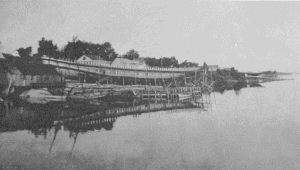
McKenzie Boat Yard Tatamagouche, Nova Scotia
Owned at one time by the Mingo Family
John Mingo, son of Matthew settled on the back road to River John in the year 1814. It was the same year a large tract of land was purchased in Middleton. That year, John married Mary Hynds. There is a record of their marriage, but no record of Mary's heritage.
It is my opinion that the land in Middleton may have been a dowry from Mary's family who may have been MicMac Indians. Up until that time there were very few white settlers in the area.
The brothers soon found wives in Canada. John was married to Mary Hynds of Middleton, NS on December 14, 1814. They were married by Rev. D. H. Frame.
John and Mary had nine children, four boys and five girls.
The children were:
Eunice
|
June 12, 1816
|
James William
|
July 30, 1818
|
Elizabeth
|
March 6, 1821
|
Michael
|
April 16, 1823
|
Jane
|
December 30, 1825
|
John Thomas
|
November 28, 1828
|
Susan
|
July 15, 1831
|
Archibald
|
April 24, 1834
|
Mary
|
January 12, 1837
|
For many years, John was a farmer and a shipbuilder. His son Arch took over the business with two partners in later years with his brother-in-law Jerimiah Murphy and Mr. Ramsey. They built what is known as Clarke's Wharf.
John died on December 15, 1860 in River John, Nova Scotia. Mary, his wife of forty six years, also died in River John six years later on August 17,1866. They are buried in the old Anglican cemetery in River John.
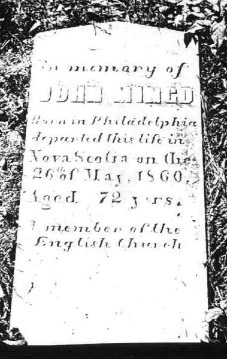
It is thought that the Mingo's married into the MicMac tribe who lived in the Tatamagouche area of Nova Scotia. Family stories handed down from previous generations say it is true.
In 1809, the three Mingo brothers and their father came from Philadelphia to finally settle on the back road to River John. This was the area of Tatamagouche which means place where two rivers meet in the language of the MicMac Indians. The Mingos were the first white settlers at that place. Many of their descendants still farm there. These brothers were instrumental in establishing the Episcopal church at River John. In 1814, he bought a parcel of land in Middleton, on the back road from River John to Tatamagouche, two and a half miles from Denmark and four and one half miles from Tatamagouche.
The land was and still is a gentle area of the province with rolling hills, rich red farming soil and the warmest waters north of the Carolinas. There is plenty of game and the fishing is excellent. To this day, the region between Tatamagouche and River John on or near the Northumberland Strait is largely unspoiled and under developed except for scattered cottages along its shores. It is easy to imagine how people lived a century or two ago, despite the electric wires and paved roadways. Most of the farm houses are as old as the first settlers. It is a healthy land and eighty or ninety year olds can still be seen baling hay in the sunshine of the fields and meadow.
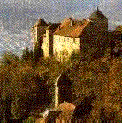
Montbeliard
Swiss/French Border
Christopher Mingo may have fought with Jean George Tattrie in the Battle of Fontenoy. It is said that Christopher was a Swiss soldier. Jean George Tattrie was born about 1722 and was granted land by DesBarres, himself from Montbeliard.
George Tattrie and his children came early to Tatamagouche. His daughter married a John Mingo in 1753. George Tattrie deeded his farm to him together with one yoke of oxen, three cows, one calf and six sheep, "in consideration of his great affection" for him.
Peter Millard came, he fought alongside Tattrie in the Battle of Fontenay. Peter's land was near Ross' Point.
All of these people settled in the same area.
Battle of Fontenoy
War of the Austrian Succession 1740-1748
A series of wars which began when England declared war on Spain in 1739. France sided with Spain in August of 1740
One of the most famous battles in the War of the Austrian succession
It was fought at a small village of the same name in western Belgium. Here on May 11, 1745, the French under Marshal Saxe (Hermann Maurice de Saxe) defeated the Allies under the Duke of Cumberland with very heavy losses
on both sides.
This reopened the struggle between Britain and France for Colonial and Naval supremacy. War was not openly declared until 1744.
When Emperor Charles VI died on October 20, 1740, it raised the question of the Austrian succession to the throne. Maria Theresa was to succeed Charles, as ruler of the Hapsburg dominions. Frederick of Prussia marched his armies into the province in Decemer 1740. Eventually, Austria, Bohemia, England, France, Spain and several other smaller countris became involved.
After the Battle of Fontenoy, the French gained a major success in the conquest of the Austrian Netherlands by Comte Hermann Maurice de Saxe May 11, 1745. Great Britain and France suffered great financial losses after the turmoil, and agreed in the Treaty of Aix-la-Chapelle on October 18, 1748, and the territories in question were divided up once more.
The Mingo Family
(Menegaux)
The Mingos came from the area of Europe known as Montbéliard. It is a French speaking area located just north of Switzerland, west of the Rhine and of Alsace. The people of this area were influenced by the various cultures of the neighboring countries of France and Germany. In the year 1598, the Edict of Nantes allowed freedom of religion. All religions were tolerated. The Edict was revoked in 1685. Those who had converted to Protestantism, became the persecuted. Their lives were made miserable by the Catholic officials. These Huguenots had little to protect their themselves, their faith and their homes, often using sticks and stones against well armed troops of the state and church. Their homes, schools and churches were burned, and many were killed. Most of those who survived fled France and journeyed to the New World.
Christopher Mingo and his brother Jasper are said to have escaped from France early in the 1700s. They settled in Philadelphia, Pennsylvania. William Penn, the Quaker had founded this colony on the basis of freedom of religion.
Soon after their arrival, the Mingo brothers set up a foundry for making pots and pans. In addition, they were skilled finish carpenters. They taught their children the ornate and intricate woodworking methods traditional to their homeland. They began to build ships to carry their wares.
Business trading was their first love and the most convenient markets were in the English colonies, now known as the United States, and the French colonies, now known as Canada. At the time, tensions were mounting between the two regions. Trading was difficult. Because Christopher’s son John spoke French, he was able to travel to the French colonies, many times with his son Matthew. Posing as fisherman, John and Matthew traded pots and pans with natives in the Atlantic area in exchange for furs, often staying in Halifax to work as bookkeepers until they were able to sail to Holland to sell their traded goods. They also traded frequently on the Great Lakes in ships built in their own family shipyard.
Matthew knew Colonel DesBarres [1722-1824], a Swiss engineer, also from Montbéliard. DesBarres had spent many years in the England. He came to America as a lieutenant in the English army in 1756. He raised and commanded a corps of field artillery. In 1757, he gained a victory over the Indians who had attacked Fort Schenectady, and at the Siege of Quebec [1759] he was an aide-de-camp to General James Wolfe, commander of the English forces in the Canadian Expedition. It was said General Wolfe fell mortally wounded while DesBarres was making a report. He conducted an engineering operations of the English army during the subsequent conquest of Canada. He was the quartermaster general in the expedition that retook Newfoundland in 1762.
Between 1763-1773 he made and exhaustive hydrographic survey of the coast of Nova Scotia, often risking his life to get difficult soundings. He was also engaged by General Lord Richard Howe to prepare charts of the North American coast as far as the Gulf of Mexico. This work took the next 16 years of his life. He became lieutenant governor of Cape Brenton [1784-1805], and of Prince Edward Island [1805-1813]. He published his own book of surveys, which prove to be of lasting value to maritimers. His notes contained numerous charts and plates of extraordinary quality. He died in Canada at the age of 102.
DesBarres, at this time offered land to Matthew Mingo. He owned thousands of acres of land which had been confiscated from the Acadians on the Northumberland shore extending from River John to Tatamagouche. The British government gave the land to DesBarres. Never-the-less, he found himself deeply in debt. Matthew loaned him some money. In repayment, DesBarres gave Matthew a parcel of land from his grant. It was agreed that Matthew’s three sons, George, John and David would settle there. For some reason, they did not do so until later. The Mingo’s land was lost.
Other Montbéilard immigrants, including more Mingo family members had sailed directly to Halifax and Lunenburg, Nova Scotia in 1751. Here they received land, and they survived until 1771 when they also moved to the North Shore with JWF DesBarres .
These people soon adopted the language and characteristics of Canada. They understood and could speak French. Their bibles and other books were written in that language. They were industrious, sober and practical. In a remarkably short time they were making a comfortable living. As may be expected of people who gave up their homeland for the sake of their faith, they were devoutly religious. In the old country, they had been Lutherans, but here most of them allied with the Presbyterian Church, as it was the first Protestant Church to send a minister to Tatamagouche.
They, as a rule, showed good judgment in the selection of their farms, taking advantage of the clearings that had been made by the Acadians. They made a little money from lumbering. In later years, shipbuilding proved to be a profitable enterprise, as they were skilled workers in wood, and had an abundant supply of lumber. In addition, a splendid harbor was close at hand. By 1775, they were a self supporting community. They were able to supply other new settlements with potatoes in that year.
In 1809, the three Mingo brothers and their father came from Philadelphia to finally settle on the
back road to River John. This was the area of Tatamagouche , which means
place where two rivers meet in the language of the MicMac Indians. The Mingos were the first white settlers at that place. Many of their descendants still farm there. These brothers were instrumental in establishing the Episcopal church at River John. In 1814, he bought a parcel of land in Middleton, on the back road from River John to Tatamagouche, two and a half miles from Denmark and four and one half miles from Tatamagouche.
The land was and still is a gentle area of the province with rolling hills, rich red farming soil and the warmest waters north of the Carolinas. There is plenty of game and the fishing is excellent. To this day, the region between Tatamagouche and River John on or near the Northumberland Strait is largely unspoiled and under developed except for scattered cottages along its shores. It is easy to imagine how people lived a century or two ago, despite the electric wires and paved roadways. Most of the farm houses are as old as the first settlers. It is a healthy land and men of eighty or ninety years old can still be seen baling hay in the sunshine of the fields and meadow.
The old burying ground of these pioneers lies along the shore a little below the junction of the French and Waugh Rivers.
There on that beautiful wooded point silently sleep the heroes of the fight around old Montbeliard.Time and tide, working incessantly, have carried away over half of this historic spot where forever the forefathers of the hamlet sleep.
Rugged spruce keep silent watch over their quiet secluded graves. These same trees saw when they first touched our shores, watched as they struggled on, and finally, when lifes work was done,saw their bodies returned to the earth from whence they came.
Colchester Sun article, July 31, 1893
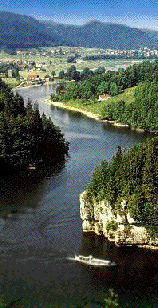
Montbeliard Today
Descendants of Christopher Mingo
Four Generations to my grandmother
Annie McKenzie Harrington
Generation No. 1
1. Christopher1 Mingo was born Abt. 1730 in Switzerland, and died in Nova Scotia. He married ? Abt. 1750 in Switzerland. She was born Abt. 1732.
Children of Christopher Mingo and ? are:
2 i. George2 Mingo, born Abt. 1751 in Switzerland; died in Halifax, Nova Scotia.
3 ii. John Mingo, born Abt. 1753 in Switzerland; died in USA.
+ 4 iii. Matthew Mingo, born Abt. 1755 in Switzerland; died in River John, Pictou, Nova Scotia.
Generation No. 2
4. Matthew2 Mingo (Christopher1) was born Abt. 1755 in Switzerland, and died in River John, Pictou, Nova Scotia. He married ? Bef. 1788 in Philadelphia, PA, USA. She was born Abt. 1755.
Children of Matthew Mingo and ? are:
+ 5 i. John3 Mingo, born January 25, 1788 in Philadelphia, PA, USA; died May 26, 1860 in River John ,Pictou County, Nova Scotia, Canada.
+ 6 ii. George Mingo, born August 16, 1782 in Philadelphia, PA; died March 17, 1855 in Halifax, NS.
+ 7 iii. David Mingo, born 1793 in Lunenburg, Lunenburg County, Nova Scotia; died March 17, 1855 in Louisville, Pictou, Nova Scotia.
+ 8 iv. Nancy Mingo, born 1794.
9 v. Elizabeth Mingo, born 1802.
10 vi. Susannah Mingo, born Abt. 1801.
11 vii. Jane Anne Mingo, born 1796.
Generation No. 3
5. John3 Mingo (Matthew2, Christopher1) was born January 25, 1788 in Philadelphia, PA, USA, and died May 26, 1860 in River John ,Pictou County, Nova Scotia, Canada. He married Mary Hynds December 15, 1814 in Nova Scotia,Canada. She was born March 4, 1793 in Tatamagouche, Nova Scotia, Canada, and died August 17, 1866 in River John ,Pictou County, Nova Scotia, Canada.
Children of John Mingo and Mary Hynds are:
12 i. Eunice4 Mingo, born 1816.
13 ii. Jim Mingo, born 1818.
14 iii. Betsy Mingo, born 1821.
+ 15 iv. Michael Mingo, born 1823 in Nova Scotia; died in Nova Scotia.
+ 16 v. John Thomas Mingo, born November 26, 1828 in Tatamagouche, Nova Scotia, Canada; died October 29, 1918 in Nova Scotia, Canada.
+ 17 vi. Susan Mingo, born July 15, 1831 in Nova Scotia, Canada; died August 2, 1881 in Nova Scotia, Canada.
18 vii. Arch Mingo, born 1834.
19 viii. Mary Mingo, born 1837.
6. George3 Mingo (Matthew2, Christopher1) was born August 16, 1782 in Philadelphia, PA, and died March 17, 1855 in Halifax, NS. He married Mary Polly Langille June 10, 1803 in Halifax, Halifax, Nova Scotia. She was born 1781 in Nova Scotia, Canada, and died in Nova Scotia.
Children of George Mingo and Mary Langille are:
20 i. Charles4 Mingo, born 1806.
21 ii. George David Mingo.
22 iii. Peter Mingo, born 1823.
23 iv. John Archibald Mingo, born 1830.
24 v. Suzie Mingo, born 1816.
25 vi. Agnes Mingo.
26 vii. George Rheuben Mingo, born 1821.
27 viii. David Henry Mingo, born 1811.
28 ix. Christy Ann Mingo.
29 x. Elizabeth Mingo.
30 xi. Janet Mingo, born 1819.
7. David3 Mingo (Matthew2, Christopher1) was born 1793 in Lunenburg, Lunenburg County, Nova Scotia, and died March 17, 1855 in Louisville, Pictou, Nova Scotia. He married Mary Ann Mattatal Abt. 1819 in Pictou, Pictou, Nova Scotia. She was born 1799 in Nova Scotia, and died April 14, 1891 in Nova Scotia.
Children of David Mingo and Mary Mattatal are:
31 i. Margaret4 Mingo, born 1821 in Nova Scotia. She married George Forbes Abt. 1836 in River John, Pictou, Nova Scotia.
32 ii. Wellwood Mingo, born 1822 in Nova Scotia; died October 28, 1906 in Nova Scotia.
33 iii. David Mingo, born 1828 in Nova Scotia; died 1910. He married Nancy Chambers.
34 iv. Mary Mingo, born 1831 in Nova Scotia; died 1881.
35 v. Sarah Jane Mingo, born 1833 in Pictou, Pictou, Nova Scotia; died April 18, 1853 in Denmark, Colchester County, Nova Scotia.
36 vi. Martha Mingo, born Abt. 1844 in Nova Scotia, Canada. She married Abram West Abt. 1860 in Nova Scotia, Canada.
+ 37 vii. Thomas Mingo, born 1841.
38 viii. George Mingo, born 1842 in Nova Scotia, Canada. He married Elizabeth Mingo Abt. 1863 in Nova Scotia, Canada; born in Nova Scotia, Canada.
+ 39 ix. Levi Mingo, born July 30, 1838 in Pictou, Pictou,Nova Scotia, Canada; died February 21, 1909 in Denmark, Colchester County, Nova Scotia.
8. Nancy3 Mingo (Matthew2, Christopher1) was born 1794. She married George Mattatal.
Child of Nancy Mingo and George Mattatal is:
40 i. Elizabeth4 Mattatal. She married Thomas Henderson.
Generation No. 4
15. Michael4 Mingo (John3, Matthew2, Christopher1) was born 1823 in Nova Scotia, and died in Nova Scotia. He married Mary Anne Matatal November 11, 1847. She was born 1836 in Nova Scotia, and died Bef. 1864 in Nova Scotia.
Child of Michael Mingo and Mary Matatal is:
41 i. Agnes Jane5 Mingo, born April 17, 1854 in Tatamagouche, Nova Scotia, Canada; died November 21, 1933 in Nova Scotia, Canada. She married Joseph Henry Harrington December 8, 1879 in Tatamagouche,Colchester County, Nova Scotia; born May 3, 1848 in River John, Nova Scotia, Canada; died Aft. 1908 in Nova Scotia, Canada.
16. John Thomas4 Mingo (John3, Matthew2, Christopher1) was born November 26, 1828 in Tatamagouche, Nova Scotia, Canada, and died October 29, 1918 in Nova Scotia, Canada. He married (1) Jesse Wilson 1855 in Nova Scotia, Canada. She was born January 12, 1834 in Nova Scotia, Canada, and died December 11, 1877 in Nova Scotia, Canada. He married (2) Christena Jane Harrington October 13, 1881 in River John, Pictou County, Nova Scotia, Canada, daughter of Lemuel Harrington and Lucy. She was born Abt. 1850 in River John, Nova Scotia, Canada, and died October 17, 1929 in Nova Scotia, Canada.
Children of John Mingo and Jesse Wilson are:
42 i. George Gordon5 Mingo, born September 17, 1874 in Nova Scotia; died September 7, 1877 in Nova Scotia.
43 ii. Margaret Jane Mingo, born June 13, 1856 in Nova Scotia; died July 1, 1879 in Nova Scotia.
44 iii. Jessie Mingo, born December 28, 1857 in Nova Scotia; died 1890 in Nova Scotia.
45 iv. Harriet J. Mingo, born September 4, 1861 in Nova Scotia, Canada; died April 10, 1892 in Nov Scotia, Canada.
46 v. Elizabeth M. Mingo, born July 9, 1860 in Nova Scotia, Canada; died June 20, 1890 in Nova Scotia, Canada. She married Matthew Reid November 1, 1887 in Nova Scotia, Canada.
47 vi. Maria Mingo, born December 17, 1863 in Nova Scotia, Canada, a twin of Martha; died February 2, 1885 in Nova Scotia, Canada, both died the same year at age 21.
48 vii. Martha Mingo, born December 17, 1863 in Nova Scotia, Canada, Twin of Maria; died May 19, 1885 in Nov Scotia, Canada, Maria died the same year, age 21.
49 viii. Adam Archibald Mingo, born December 22, 1871 in Nova Scotia, Canada; died June 3, 1893 in Nova Scotia, Canada.
50 ix. John Geddie Mingo, born May 9, 1866 in Nova Scotia, Canada; died November 26, 1893 in Nova Scotia, Canada. He married Amy W. Reid September 23, 1891 in Nova Scotia, Canada; born in Nova Scotia, Canada; died in Nova Scotia, Canada.
51 x. William Waddell Mingo, born May 8, 1870 in Nova Scotia, Canada; died December 3, 1891 in Nova Scotia, Canada.
52 xi. Thomas Daniel Mingo, born March 24, 1868 in Nova Scotia, Canada; died December 27, 1956 in Nova Scotia, Canada. He married Bessie Henderson 1887 in Nova Scotia, Canada.
Child of John Mingo and Christena Harrington is:
53 i. Gordon A.5 Mingo, born September 22, 1878 in Nova Scotia; died September 24, 1960 in Nova Scotia.
17. Susan4 Mingo (John3, Matthew2, Christopher1) was born July 15, 1831 in Nova Scotia, Canada, and died August 2, 1881 in Nova Scotia, Canada. She married Lemuel William Harrington February 15, 1854 in Tatamagouche, Nova Scotia, Canada. He was born 1815 in Quebec, Canada, and died Aft. 1881.
Children of Susan Mingo and Lemuel Harrington are:
54 i. Susan5 Harrington, born 1842 in Nova Scotia, Canada; died 1881 in Nova Scotia, Canada; Stepchild. She married Levi Mingo Bef. 1860 in Nova Scotia, Canada; born July 30, 1838 in Pictou, Pictou,Nova Scotia, Canada; died February 21, 1909 in Denmark, Colchester County, Nova Scotia.
55 ii. John Harrington, born Abt. 1845 in Nova Scotia, Canada; Stepchild.
56 iii. Kate Harrington, born 1855.
57 iv. George William Harrington, born March 9, 1857 in Nova Scotia, Canada; died December 23, 1936 in Nova Scotia, Canada.
58 v. James Archibald Harrington, born Abt. December 14, 1859 in River John, Nova Scotia, Canada; died May 30, 1883 in Nova Scotia, Canada. He married Henrietta Grant Mingo August 17, 1880 in Rev. Crandall, Baptist Church, Tatamagouche, Nova Scotia, Canada; born September 26, 1863 in Tatamagouche, Nova Scotia, Canada; died in Nova Scotia, Canada.
59 vi. Agnes Harrington, born Abt. December 1, 1860 in Nova Scotia, Canada.
60 vii. Cornelia Gordon Harrington, born April 23, 1863 in Nova Scotia, Canada; died in USA. She married Jerimiah Angell Sheldon, Jr. January 5, 1887 in Arnold's Mills, Cumberland, Providence County, Rhode Island; born 1866 in North Scituate, RI; died in USA.
61 viii. Annie McKenzie Harrington, born March 11, 1870 in Tatamagouche,Colchester County, Nova Scotia; died May 20, 1941 in North Attleboro, MA. She married William George Dyer June 23, 1887 in Arnold's Mills, Cumberland, RI; born May 13, 1859 in New York; died December 15, 1936 in Plainville, Norfolk County, MA.
37. Thomas4 Mingo (David3, Matthew2, Christopher1) was born 1841. He married Agnes Jane MIngo. She was born 1837.
Child of Thomas Mingo and Agnes MIngo is:
62 i. Henrietta Grant5 Mingo, born September 26, 1863 in Tatamagouche, Nova Scotia, Canada; died in Nova Scotia, Canada. She married James Archibald Harrington August 17, 1880 in Rev. Crandall, Baptist Church, Tatamagouche, Nova Scotia, Canada; born Abt. December 14, 1859 in River John, Nova Scotia, Canada; died May 30, 1883 in Nova Scotia, Canada.
39. Levi4 Mingo (David3, Matthew2, Christopher1) was born July 30, 1838 in Pictou, Pictou,Nova Scotia, Canada, and died February 21, 1909 in Denmark, Colchester County, Nova Scotia. He married Susan Harrington Bef. 1860 in Nova Scotia, Canada, daughter of Lemuel Harrington and Susan Mingo. She was born 1842 in Nova Scotia, Canada, and died 1881 in Nova Scotia, Canada.
Children of Levi Mingo and Susan Harrington are:
63 i. Steward Alfred5 Mingo, born 1860.
64 ii. Henry Howard Mingo, born 1862.
65 iii. Elinor Jane Mingo, born 1864.
66 iv. Lemuel William Mingo, born 1866 in Nov Scotia, Canada; died December 3, 1875 in Nova Scotia, Canada.
67 v. Ernest William Mingo, born 1868; died November 20, 1875 in Nova Scotia, Canada.
68 vi. Ellis Rose Mingo, born 1870.
69 vii. Ethel Maude Mingo, born 1879.
70 viii. Catherine Mary Matilda Mingo, born 1871.
71 ix. Ada Seville Mingo, born 1874.
72 x. Bertha Florence Mingo.
73 xi. Adela Mebeim Mingo, born 1880.
74 xii. Child Mingo.
Montbéliard is a small city in eastern France, in the department of Doubs, some 400 kilometers (250 miles) southeast of Paris. Until 1793, Montbéliard was the independent homeland of about 420 French-speaking Protestants brought to Nova Scotia by a Dutch shipping agent named John Dick. Dick was appointed by the British Board of Trade to recruit "Foreign Protestants" along the Rhine to settle in Nova Scotia, which at that time was a remote, and with the Treaty of Ultrect in 1713, a fairly recently acquired British colony.
Photos and Maps
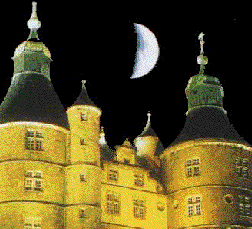 |
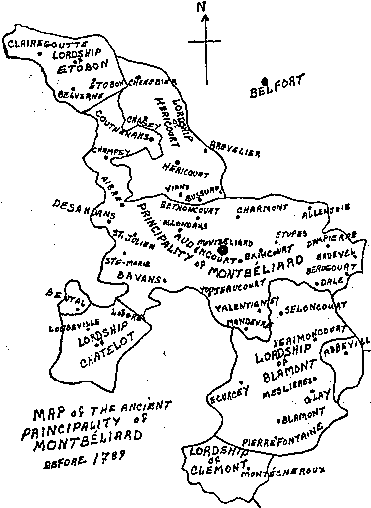 |
 |
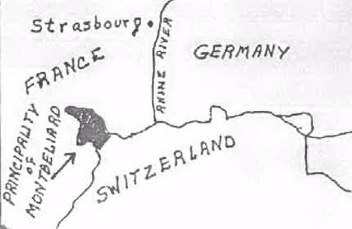 |